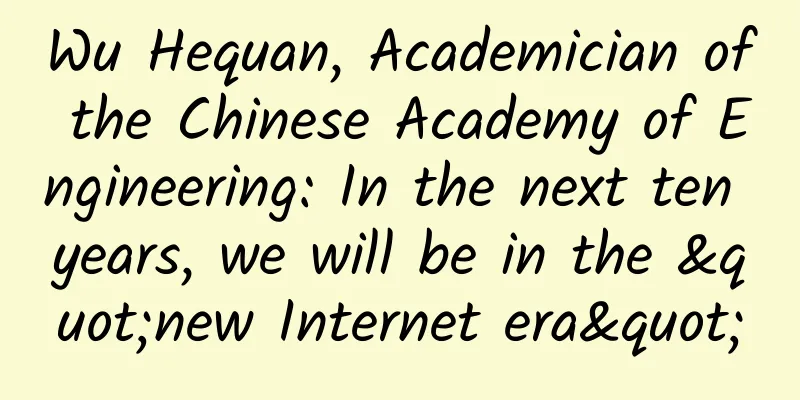Wu Hequan, Academician of the Chinese Academy of Engineering: In the next ten years, we will be in the "new Internet era"

|
As an important part of the 2025 Zhongguancun Forum Annual Conference, among the 60 parallel forums, how artificial intelligence technology, as a new type of productive force, will reshape the future industrial landscape has undoubtedly become one of the most eye-catching highlights and hot topics of this forum. On the afternoon of March 29, the "Future Internet Industry Development Forum" was successfully held at the Zhongguancun International Innovation Center, hosted by the Beijing Association for Science and Technology and China Unicom, and co-organized by the Innovation Service Center of the Beijing Association for Science and Technology, the ASEAN Federation of Engineering Organizations (AFEO), the Beijing Science and Technology International Exchange Center, the Beijing Society of Engineers and the Beijing Enterprise Technology Development Research Association. The theme of this event is "Technology Integration and Industrial Transformation in the Intelligent Era". Dozens of experts from home and abroad focused on cutting-edge technologies such as artificial intelligence, 6G, Internet of Things, and big models, and made wonderful speeches on how the next generation of Internet will reconstruct the global industrial ecology and promote digital transformation. About 180 relevant leaders and scholars from home and abroad participated in this event, jointly drawing a future map for the new generation of Internet and contributing new ideas, new perspectives, and new technologies to the global economic transformation. Among them, in the keynote speech session of the event, Wu Hequan, academician of the Chinese Academy of Engineering and former vice president of the Chinese Academy of Engineering, gave a speech entitled "Using AI to Empower Network Reconstruction and Model Transformation", in which he deeply analyzed the far-reaching impact of artificial intelligence on the future Internet architecture. He pointed out that the current Internet has entered the "digital era", and from 2025 to 2035, the Internet will usher in a new decade and enter the "new quality Internet" era that supports the development of new quality productivity. He pointed out that artificial intelligence technology has profoundly changed the global competition landscape and will also reshape the way the world and we are constituted: "AI will promote the Internet to leap towards intelligence and adaptability, and reconstruct the core logic of industries, medical care, education and other fields." What does the "new Internet" of "AI+" look like? What changes will it bring to our lives? The "Government Work Report" has deployed "artificial intelligence +" for two consecutive years. Compared with the traditional Internet, what is the difference between the "AI +" "new Internet"? Academician Wu Hequan pointed out that the rapid development of AI is not only continuously reshaping the terminal form, network infrastructure and industrial application model of the future Internet, but the combination of AI and 6G will also give birth to a new communication paradigm. Academician Wu Hequan said that first of all, from the perspective of data flow, in the past, the demand for Internet applications was mainly for "downloading" - that is, data was mainly transmitted from the cloud to the terminal, and there was less demand for uploading. In the era of "new quality Internet", the terminal may no longer be just a receiver of data, but also a producer of data. Academician Wu described a vivid scenario: the video content generated by AI applications in the future will involve 3D images, a combination of virtual and real content, etc., which means that the demand for high bandwidth in the uplink and downlink of the network will increase significantly. Academician Wu Hequan introduced that, at present, although my country's bandwidth has achieved "100M penetration rate over 95%, Gigabit coverage over 30%", and is promoting "10G access" at the same time, this is mainly aimed at improving downlink bandwidth, and the upload bandwidth capacity is still limited. "In the past, our home network was 'one-to-many' transmission, and the upload demand was generally not high. In the future, it may change with the 'many-to-one' upload demand. Adjustment of network architecture will first be an important issue." Secondly, Academician Wu Hequan also mentioned that in the future, AI applications will place higher requirements on "low latency, high bandwidth, low cost, and zero packet loss rate" networks in scenarios such as cross-regional data interaction and collaborative computing of multiple computing centers. Future networks need to have more flexible scheduling capabilities, such as allocating large bandwidth resources in a short period of time, hierarchical management of ordinary data and important data, and even requiring corresponding security protection and differentiated services for data transmission in critical scenarios. These mean that the network needs more optimization in design, including the deployment and improvement of routing mechanisms, data caching strategies, and traffic management. Academician Wu Hequan also took everyone to look forward to the future use scenarios of the "AI+" new Internet: in addition to the ground, it has expanded to application areas such as vehicle networking, low-altitude economy, and satellite communications. He said, "With the arrival of 6G, future networks will expand more frequencies, become more green and intelligent, and promote the reshaping of the entire Internet ecosystem. Terminals are no longer limited to the ground and fixed, but will cover a variety of forms including mobile cars, drones in the air, and satellites in the sky. At the same time, in different environments, at the lowest possible cost, it will provide users with the smoothest network experience." Finally, Academician Wu Hequan also emphasized that the research on 6G does not mean that the problems of 5G are ignored. On the contrary, many 6G-related research results can "feed back" to 5G and be used to optimize the existing network architecture to better adapt to the needs of the AI era. Deepseek has not completely solved the problem of large model implementation Access to high-quality data will remain a challenge In the era of artificial intelligence, whoever has access to scarce high-quality data may own the world of big model applications. When talking about solving the pain point of the difficulty in implementing large models in my country, Academician Wu Hequan mentioned the Deepseek large model, which "dazzled people's eyes at the beginning of this year." He believes that the advantage of Deepseek is that it has achieved the current top large model performance while greatly reducing the computational complexity. "It has lowered the threshold for the use of large models, attracted more industries to pay attention to the development of large models, and also shortened the distance between enterprises and large models." However, "it has not completely solved the problem of large model implementation," and "the acquisition of high-quality data with high accuracy, consistency, integrity, reliability, and proprietary will still face many challenges in the future." Academician Wu Hequan said that both training large models and promoting industry applications are inseparable from high-quality data. For example, in the field of intelligent transportation, the cost of obtaining city-level data is extremely high. Although AI can be used to generate some data, the prerequisite is that a certain amount of original data must be available first. In addition, data labeling is also a major problem. For fields such as face recognition and natural language processing, although labeling requires manual participation, the overall threshold is relatively low. However, in industrial fields, such as professional data such as oil exploration, professionals are often required to participate, resulting in extremely high data acquisition costs. At the same time, security issues cannot be ignored. Data security includes both network security challenges and business integrity and sharing issues. He called for the development of technology in the future that can both conduct data mining and ensure the safe flow of data. "Of course, this involves not only technology, but also management considerations." In addition to facing the challenge of "difficulty in obtaining high-quality data", Academician Wu Hequan also pointed out that future industry applications will also need to solve problems such as multimodal large models such as videos and images in addition to large language models; the problem of improving the ability of large models to be more autonomous and intelligent in more complex scenarios; in addition to "cloud services", the demand scenarios for local operation of "sinking to the terminal"; the credibility of AI and other difficult problems. Although large models are powerful and cover a wide range of functions, they are often "big but not powerful" when it comes to specific tasks and scenarios. Therefore, Academician Wu Hequan also proposed to develop multiple "small models" and "small programs" for different scenarios in specific industry applications and consumer ends to supplement and enrich the "ecology" of AI applications. "Only in this way can the widespread implementation of large models in the future be truly realized." Source: Beijing Science and Technology News |
<<: Why does the whole camellia fall to the ground when it "closes its curtain"?
Recommend
How much has the visual system of Apple's OS X changed after 13 years?
After a long beta period, OS X 10.10 Yosemite is ...
New material inspired by mussels could prevent secondary damage to wounds
Author Li Chuanfu Wound healing is a complex proc...
Kaikeba Enterprise-level Task-based Dialogue Robot [4,5,6]
Kaikeba Enterprise-level Task-based Dialogue Robo...
Learn these two tips on how to use iPhone and win PUBG is no longer a dream
As PlayerUnknown's Battlegrounds becomes popu...
Case analysis: How to build a user incentive system?
The construction of a user incentive system is ge...
Android 9.0 will ban developers from using unofficial APIs
According to the developer forum XDA, a recent su...
How to refine bidding promotion accounts and improve promotion effects!
When we do promotion, the proportion of bidding p...
Lenovo S5 review: a 1,000 yuan phone with balanced configuration and no flaws
When Trump took the initiative to start the Sino-...
Can Paipai Weidian change shopping habits?
On one hand, there are constantly updated stories...
Medical AI technology is hot, but where does its business model end?
These are exciting times. With the huge wave of i...
When taking over a new project, how can we quickly develop a reliable operation and promotion plan?
When taking over a new project, how can you quick...
Do you think your scalp is dandruff when it flakes off? Doctors from West China University of Political Science and Law warn you to be careful of this common skin disease in winter!
Psoriasis, a strange name, but when it comes to a...
What is the Great Wall?
Collision breeds colorful Collision creates power...
360's new phone will adopt a borderless design, OPPO may be the first to ship
According to information on the website of the St...
Why use blogs to promote your website? How to promote your products online?
Blog promotion is a form of Internet promotion, a...









